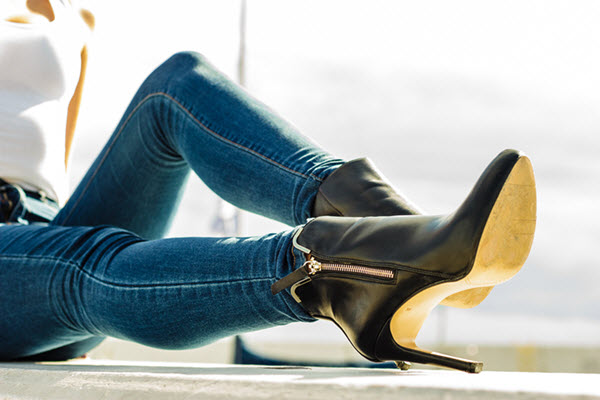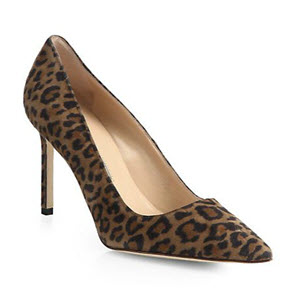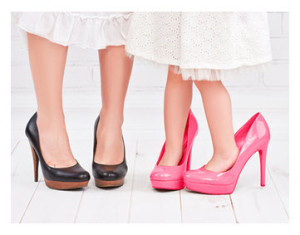When I saw the illustration depicting a white high-heeled bootie melting into a glossy puddle, I couldn’t resist. The title further enticed me as, in her recent New York Times article, writer Bonnie Wertheim asks, “Are High Heels Headed for a Tumble?” Compelled to read on, I braced myself for a combination of consternation and amusement.

But color me surprised. Rather than addressing price, (im)practicality, or injury relative to our continuing love-hate relationship with women’s shoes, Ms. Wertheim’s provocative words feature a number of footwear facts, but primarily highlight the subtle social cues (of shoes) and other issues of “everyday sexism” they just may represent.
What sparked her points?
Emojis. Do They Matter?
Ms. Wertheim recounts a story of a high-heeled pump emoji that was one subconscious gender stereotype too many for Florie Hutchinson, an arts publicist, irritated at its appearance when she typed the word “shoe” into her phone. There were no ballet flats, no walking shoes, no work boots or other footwear options with a less seemingly sexualized slant.
Given the exposure we all have to all kinds of (stereotyped) imagery, particularly around female appearance and roles, does one little emoji really matter? Are we more impacted by that ubiquitous red heel than we realize? What of our children who are texting, and that is the only option they see for a woman’s shoe? Does that matter? Are there “bigger” battles to fight?
It’s Been a Helluva Year for Women in the US
Ms. Wertheim reminds us of the recent stream of women whose
… stories of sexual harassment and assault have prompted a purge of powerful men in entertainment, government and media.
Moreover, she points out:
In growing numbers, they are running for public office… Some of them are also fighting gender discrimination with their footwear.
Ms. Wertheim further makes a point of raising issues around our choices when it comes to feeling safe. In other words, if we have to, can we run? And in this instance, I don’t mean for office. This goes beyond avoiding uncomfortable situations in which assumptions about our sexual availability are likely. (That said, we have only to look at recent events in the news, many of which illustrate egregious acts that have absolutely nothing to do with what a woman wears and everything to do with abuse of power.)
Safety. It’s About More Than Sprained Ankles.
Now, when you think of high heel safety, you may be considering whether or not you topple, sprain an ankle, or get your pricey stiletto stuck in a street grate. On the other hand, for many of us over the years, safety in our attire is about something else — however wrong-headed it seems. It is about an awareness of needing to take a subway or walk through certain neighborhoods at night, including areas we believe to be “safe.”
This is about appearing “unapproachable” — or at least less vulnerable to any sort of unwanted approach — as well as the ability to run away if necessary. For me (and for you?), this is a teaching that dates back to early adolescence. Likewise, I was taught to pay attention to how the clothes I am wearing would be “perceived” by complete strangers, especially in public areas or on a little-traveled street… as a matter of personal safety.
Do the Clothes Make the Man? Do the Shoes Make the Woman?
To what extent does this tie into a subject like emojis on our phones that offer only (theoretically) sexualized footwear? Or limit the ways in which our daughters — or we ourselves — see our options? What about those of us who feel more confident — more powerful — when we’re wearing what we perceive to be a “power heel?”
 To what extent does this tie into the many conversations we’ve been having relative to sexual misconduct and sexual harassment? Does this give fuel to the fire that women are somehow “to blame” when they dress a certain way if they are approached in an inappropriate sexual manner?
To what extent does this tie into the many conversations we’ve been having relative to sexual misconduct and sexual harassment? Does this give fuel to the fire that women are somehow “to blame” when they dress a certain way if they are approached in an inappropriate sexual manner?
And yet isn’t appearance still a primary factor in how our performance is perceived, how much we are paid, and not necessarily in positions where appearance has anything to do with the job?
As a woman of petite stature, I’ve worn heels for as long as I can remember — anything from about two inches to the occasional five-inch platform a few years back, though rarely. (I continue to consider huge platforms heavy, unflattering, and extremely impractical.)
Image Matters. Maybe Images Matter More.
I have been concerned for a number of years at the “fashion statements” we see plastered on our screens. I may not care for some of them, but I will defend the right of any woman to wear what she pleases.
As much as I adore my elegant Edelmans and covet classic Manolos, my preference, throughout a long corporate career, was a heel height in a pretty, professional and pragmatic two to three inches. Moreover, as much as I appreciate shoes as fashion art, I pad around barefoot or in socks (working from home), and I do my serious walking in well-worn sneakers. To see a client, make a presentation, or go on a date — as you might expect — I opt for an appropriate heel (for the occasion), as comfy as possible.
Surely we can agree that the subtleties of sexualization are everywhere, and many (most?) of us would understand Ms. Wertheim’s point. Images of all sorts have a cumulative effect, and a powerful subconscious one at that.
These Boots Are Made for Walkin’…
 As for those emojis, I might like to see some snow boots, or yellow galoshes, or a leopard ballet flat, or a cutie of a bootie with a kitten heel, or even a Nancy Sinatra boot that actually could be comfortably walked in. And yes, all options available as I text a friend. But more importantly, I would like what they represent to be viewed as normal — women involved in every aspect of life that they, as individuals, wish to engage in — from building homes to building software, and from running races to running for office.
As for those emojis, I might like to see some snow boots, or yellow galoshes, or a leopard ballet flat, or a cutie of a bootie with a kitten heel, or even a Nancy Sinatra boot that actually could be comfortably walked in. And yes, all options available as I text a friend. But more importantly, I would like what they represent to be viewed as normal — women involved in every aspect of life that they, as individuals, wish to engage in — from building homes to building software, and from running races to running for office.
And beyond winning, governing. In other words, not just getting the job, but doing the job — wisely and well.
In the meantime, anything that helps us rethink the narrow gender-based cues and assumptions we take as “givens” seems worthwhile to me.
I welcome your thoughts.
Leopard Manolo, Saks Fifth Avenue.
You May Also Enjoy
In the ’90s the super-high heels were referred to as “come f* me” shoes. Platform stilettos were seen only in sex shops. It’s all part of the pornification of women’s fashion. It starts with celebrities trying to be “edgy” and a little “transgressive,” then gets adopted by the masses. Then being “edgy” and “transgressive” requires something even more outrageous, and you end up with office attire that once would have been seen only in the wildest clubs.
In my office days, I wore flats to work–for safety, for being able to flee–and had a drawer full of what would today be considered dowdy-height heels. But even though most of my walking was in sensible shoes, I eventually had to get bunion surgery. No more heels for me. Plus, I have yet to see a woman striding confidently in heels, rather than teetering inelegantly.
Chuckling. Yes, I do recall.